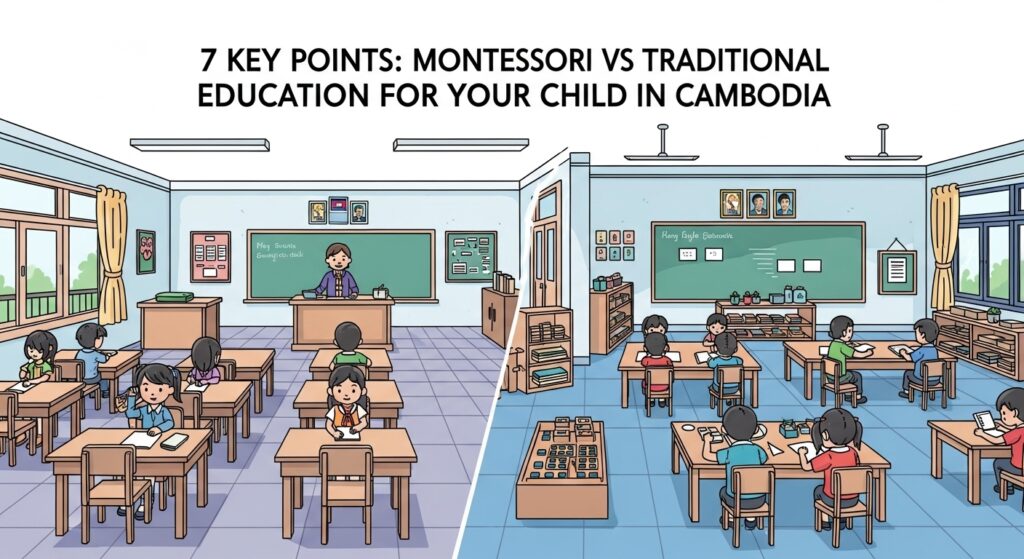
Montessori vs Traditional Education in Cambodia: 7 Key Differences for Your Child
Choosing the right school for your child is one of the most important and exciting decisions a parent can make. In Cambodia, two popular educational paths are often compared: Montessori schools and Traditional schools. Both have their advantages, but how do you decide which is the best fit for your child?
This guide breaks down the key differences between Montessori and Traditional education in Cambodia, helping you make a confident and informed decision for your child’s future.
What is Traditional Education?
Traditional education in Cambodia typically follows a structured, teacher-led format. Students are grouped by age, follow a fixed schedule, and learn through textbooks, lectures, and standardized testing. The focus is often on completing a national or international curriculum, progressing grade by grade.
What is Montessori Education?
Montessori schools in Cambodia use a child-centered method developed by Dr. Maria Montessori. These schools promote self-directed learning in mixed-age classrooms using hands-on materials. Teachers act as guides, supporting each child’s natural curiosity and pace of learning.
7 Key Differences: Montessori vs Traditional Education in Cambodia
1. Classroom Setup & Learning Environment
-
Montessori schools Cambodia: Beautifully prepared spaces with child-sized furniture, open shelves, and tactile learning tools. Students move freely and work independently or in small groups. Mixed-age classes (e.g., 3–6 years) are common.
-
Traditional schools in Cambodia: Desks in rows or small groups, with centralized teaching from a board or screen. Materials are often textbook-based, and classes are grouped by age.
2. Role of the Teacher
-
Montessori: Teachers are guides, encouraging independence and self-discovery. They observe students closely and present lessons individually or in small groups.
-
Traditional: Teachers lead lessons for the whole class, controlling the pace and content. They are the main source of knowledge.
3. Learning Pace & Curriculum
-
Montessori: Individualized learning where children progress when they’re ready. The curriculum is broad and integrated—covering life skills, culture, math, language, and more.
-
Traditional: Uniform pace set for all students. Subjects are taught separately, and learning follows a schedule aligned with exams and standards.
4. Assessment & Progress
-
Montessori: Focus on mastery and intrinsic motivation. Teachers assess through observation, portfolios, and detailed progress reports. Testing is minimal.
-
Traditional: Standardized assessments, quizzes, and exams are the norm. Grades and report cards are used to compare student performance.
5. Social Interaction
-
Montessori: Mixed-age classrooms promote mentoring and cooperation. Children learn to work collaboratively and resolve conflicts independently.
-
Traditional: Students interact mostly with same-age peers. Group activities and recess are the main social opportunities.
6. Discipline & Freedom
-
Montessori: Freedom within limits. Children choose their work, manage their time, and learn through natural consequences.
-
Traditional: Clear rules enforced by teachers. Discipline often involves external rewards and consequences.
7. Cost & Accessibility in Cambodia
-
Montessori in Cambodia: Montessori schools—especially internationally accredited ones—are mainly found in cities like Phnom Penh and Siem Reap. They often charge higher tuition due to specialized materials and teacher training.
-
Traditional schools Cambodia: Widely available, from free public schools in Cambodia to mid-range and high-end private schools. Options exist across all provinces, making them more accessible.
How to Choose the Right School in Cambodia
Choosing between Montessori and Traditional schools in Cambodia comes down to your child’s personality, your family values, and practical factors:
-
Observe Your Child: Do they thrive with structure or enjoy freedom? Are they independent or group-oriented?
-
Visit Schools in Cambodia: Tour classrooms, talk to teachers, and get a feel for the environment.
-
Review Your Educational Goals: Do you value creativity and independence, or academic benchmarks and consistency?
-
Consider Practicalities: Location, transportation, school hours, and school fees in Cambodia are all important to evaluate.
Final Thoughts
There’s no one-size-fits-all answer when choosing between Montessori and Traditional education in Cambodia. Each child is unique, and each family has different priorities. Whether you choose a Montessori school in Phnom Penh, a traditional public school in Cambodia, or something in between, the most important thing is to find an environment where your child feels happy, engaged, and inspired to learn.


